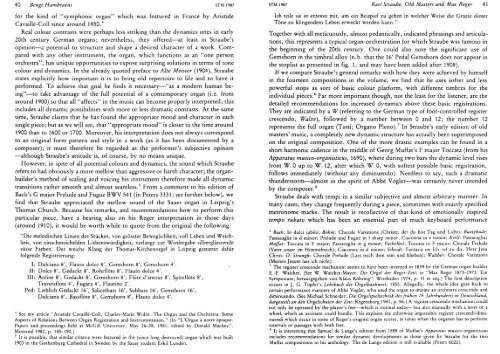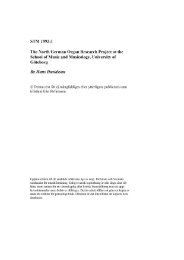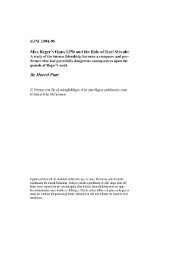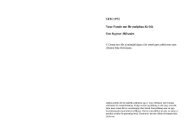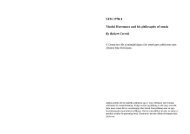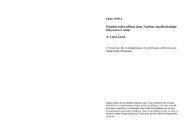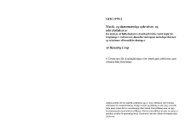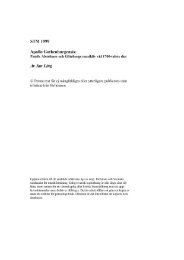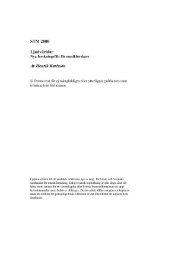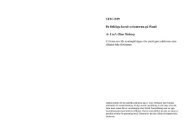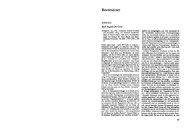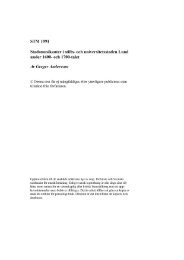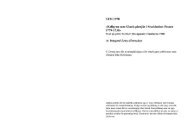You also want an ePaper? Increase the reach of your titles
YUMPU automatically turns print PDFs into web optimized ePapers that Google loves.
for the kind of “symphonic organ” which was featured in France by Aristide<br />
Cavaillé-Coll since around 1850.4<br />
Real colour contrasts were perhaps less striking than the dynamics ones in early<br />
20th century German organs; nevertheless, they offered-at least in Straube’s<br />
opinion-a potential to structure and shape a desired character of a work. Com-<br />
pared with any other instrument, the organ, which functions as an “one person<br />
orchestra”, has unique opportunities to expose surprising solutions in terms of tone<br />
colour and dynamics. In the already quoted preface to Alte Meister (1904), Straube<br />
states explicitly how important it is to bring old repertoire to life and to have it<br />
performed. To achieve that goal he finds it necessary—“as a modern human be-<br />
ing”-to take advantage of the full potential of a contemporary organ (i.e. from<br />
around 1900) so that all “affects” in the music can become properly interpreted; this<br />
includes all dynamic possibilities with more or less dramatic contrasts. At the same<br />
time, Straube claims that he has found the appropriate mood and character in each<br />
single piece; but as we will see, that “appropriate mood” is closer to the time around<br />
1900 than to 1600 or 1700. Moreover, his interpretation does not always correspond<br />
to an original form pattern and style in a work (as it has been documented by a<br />
composer); it must therefore be regarded as the performer’s subjective opinion<br />
-although Straube’s attitude is, of course, by no means unique.<br />
However, in spite of all potential colours and dynamics, the sound which Straube<br />
refers to had obviously a more mellow than aggressive or harsh character; the organ-<br />
builder’s method of scaling and voicing his instrument therefore made all dynamic<br />
transitions rather smooth and almost seamless.5 From a comment to his edition of<br />
Bach’s G major Prelude and Fugue BWV 541 (in Peters 3331; see further below), we<br />
find that Straube appreciated the mellow sound of the Sauer organ in Leipzig’s<br />
Thomas Church. Because his remarks, and recommendations how to perform this<br />
particular piece, have a bearing also on his Reger interpretation in those days<br />
(around 1910), it would be worth while to quote from the original the following:<br />
“Die melodischen Linien des Stückes, von grösster Beweglichkeit, voll Leben und Weich-<br />
heit, von einschmeichelden Liebenswürdigkeit, verlange zur Wiedergabe silberglänzende<br />
süsse Farben. Der weiche Klang der Thomas-Kirchenorgel in Leipzig gestattet dafür<br />
folgende Registrierung:<br />
I: Dulciana 8’, Flauto dolce 8’, Gemshorn 8’, Gemshorn 4’.<br />
II: Dolce 8‘, Gedackt 8‘, Rohrflöte 8’, Flauto dolce 4‘.<br />
III: Äoline 8’, Gedackt 8’, Gemshorn 8’, Flûte d’amour 8’, Spitzflöte 8’,<br />
Traversflöte 4’, Fugara 4’, Flautino 2’.<br />
Ped: Lieblich Gedackt 16’, Salicetbass 16’, Subbass 16’, Gemshorn 16’,<br />
Dulciana 8’, Bassflöte 8’, Gemshorn 8’, Flauto dolce 4’.<br />
4 See my article “Aristide Cavaillé-Coll, Charles-Marie Widor: The Organ and the Orchestra. Some<br />
Aspects of Relations Between Organ Registration and Instrumentation.” (In “L’Orgue à notre époque.<br />
Papers and proceedings held at McGill University, May 26-28, 1981, edited by Donald Mackey”.<br />
Montréal 1982, p. 185-190.)<br />
5 It is possible, that similar criteria were featured in the (since long destroyed) organ which was built<br />
1903 in the Gothenburg Cathedral in Sweden by the Sauer student Eskil Lundén.<br />
Ich teile sie in extenso mit, um ein Beispiel zu geben in welcher Weise die Grazie dieser<br />
Töne zu klingendem Leben erweckt werden kann.”<br />
Together with all meticuously, almost pedantically, indicated phrasings and articula-<br />
tions, this represents a typical organ-orchestration for which Straube was famous in<br />
the beginning of the 20th century. One could also note the significant use of<br />
Gemshorn in the timbra1 alloy (n.b. that the 16’ Pedal Gemshorn does not appear in<br />
the stoplist as presented in fig. 1, and may have been added after 1908).<br />
If we compare Straube’s general remarks with how they were achieved by himself<br />
in the fourteen compositions in the volume, we find that he uses softer and less<br />
powerful stops as sort of basic colour platform, with different timbres for the<br />
individual pieces.6 Far more important though, not the least for the listener, are the<br />
detailed recommendations for increased dynamics above these basic registrations.<br />
They are indicated by a W (referring to the German type of foot-controlled register<br />
crescendo, Walze), followed by a number between O and 12; the number 12<br />
represents the full organ (Tutti; Organo Pleno).’ In Straube’s early edition of old<br />
masters’ music, a completely new dynamic structure has actually been superimposed<br />
on the original composition. One of the more drastic examples can be found in a<br />
short harmonic cadence in the middle of Georg Muffat’s F major Toccata (from his<br />
Apparatus musico-organisticus, 1690), where during two bars the dynamic level rises<br />
from W. O up to W. 12, after which W. O, with softest possible basic registration,<br />
follows immediately (without any diminuendo). Needless to say, such a dramatic<br />
thunderstorm-almost in the spirit of Abbé Vogler-was certainly never intended<br />
by the composer.8<br />
Straube deals with tempi in a similar subjective and almost arbitrary manner. In<br />
many cases, they change frequently during a piece, sometimes with exactly specified<br />
metronome marks. The result is recollective of that kind of emotionally inspired<br />
tempo rubato which has been an essential part of much keyboard performance<br />
6 Bach: In dulci jubilo; Böhm: Chorale Variations (Christe, der du bist Tag und Licht); Buxtehude:<br />
Passacaglia in d minor; Prelude and Fugue in f sharp minor; Ciaconna in e minor; Kerll: Passacaglia;<br />
Muffar: Toccata in F major; Passacaglia in g minor; Pachelbel: Toccata in F major; Chorale Prelude<br />
(Vater unser im Himmelreich); Ciaconna in d minor; Scheidt: Fantasia on Ich ruf zu dir, Herr Jesu<br />
Christ; D. Strungk: Chorale Prelude (Lass mich dein sein und bleiben); Walther: Chorale Variations<br />
(Meinen Jesum lass ich nicht).<br />
7 The register crescendo mechanism seems to have been invented in 1839 by the German organ builder<br />
E.-F. Walcker. (See W. Walcker-Mayer: Die Orgel der Reger-Zeit; in “Max Reger 1873-1973. Ein<br />
Symposium; herausgegeben von Klaus Röhring”. Wiesbaden 1974, p. 3 1 et seq.) The first description<br />
occurs in J. G. Töpfer’s Lehrbuch der Orgelbaukunst, 1855. Allegedly, the whole idea goes back to<br />
certain performance manners of Abbé Vogler, who used the organ to imitate an orchestra crescendo and<br />
diminuendo. (See Michael Schneider: Die Orgelspieltechnik des frühen 19. Jahrhunderts in Deutschland,<br />
dargestellt an den Orgelschulen der Zeit; Regensburg 1941, p. 56.) A register crescendo mechanism could<br />
not only be operated by the player’s feet-which is normal today-but also manually with a lever or a<br />
wheel, which an assistant could handle. This explains the otherwise impossible register crescendi/diminuendi<br />
which occur in some of Reger’s original organ scores, at times when the organist has to perform<br />
intervals or passages with both feet.<br />
8 It is interesting that Samuel de Lange’s edition from 1888 of Muffat’s Apparatus musico-organisticus<br />
includes recommendations for similar dynamic developments as those given by Straube for the two<br />
Muffat compositions in his anthology. The de Lange edition is still available (Peters 6020).


